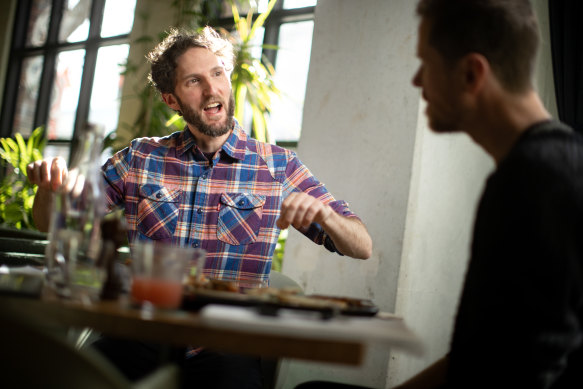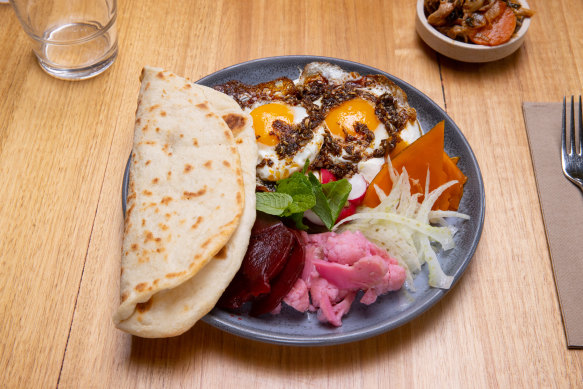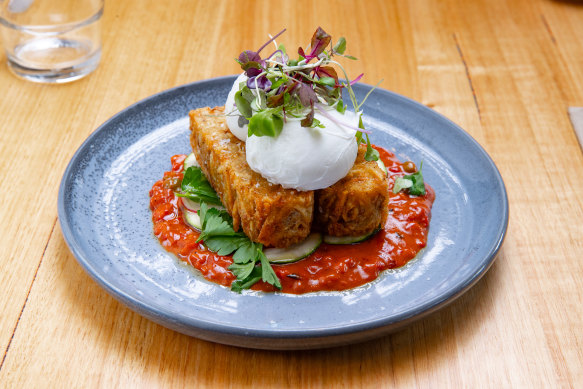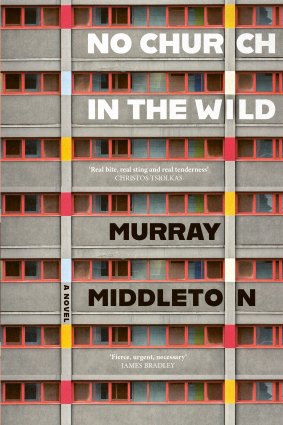‘I thought, this is the most interesting story about the city I live in’
By Adam Carey
Early in Murray Middleton’s fierce and brilliant first novel No Church in the Wild, central character Ali perceives the class divisions of his neighbourhood with all the clear-eyed cynicism of a teenage refugee who understands his place in the world.
“Million-dollar houses across the road from blocks of graffitied low-rises, crawling with rats and cockroaches, both sides always seeing each other as a threat,” he muses to himself.

Novelist Murray Middleton has written about the housing towers of Flemington.Credit: Simon Schluter
The scene is inner-city Flemington some time in the 2010s, as the suburb is being reshaped by parallel waves of African migration and gentrification.
Somali-born Ali and his friends live in the housing commission towers of Debney Meadows. Their home has been part of the multicultural heartbeat of inner Melbourne since the 1960s, but the East African youths that drive Middleton’s novel see constant reminders that they are not truly accepted in this scene.
“The skippies regret letting the people from the towers have somewhere so expensive to enjoy their cultures, even though none of them ever say it from their own mouths,” Ali’s monologue continues.
Then, in a moment of accidental prescience for the author: “Someday soon the government will demolish the four towers because the real estate prices are going to be too good to let anyone stay.”
Mostly written in the years before COVID, and well before the state government unveiled its plan to demolish the towers, Middleton’s novel is a story about race, class and the exercise of power, inspired by the people who call the towers home.
“I thought, this is the most interesting story about the city I live in. I should tell that story,” Middleton says of his chosen subject.
The novel has a through-line of hometown literary influences that runs from Christos Tsiolkas’ landmark debut Loaded to Helen Garner’s grunge-lit precursor Monkey Grip.
It is informed by his own experience growing up in Melbourne’s inner north, by years working inside Flemington’s only public secondary school, and by hundreds of hours of interviews he conducted with former students, their families, their teachers and local police.
That access to the towers’ residents, who opened up to him about their lives, gave Middleton licence for the book’s “unflinching realism”. It is fictional but takes its cue from real events, such as the sacking of three Sunshine police officers over derogatory “mudfish” beer coasters.
“I had amazing access and that created a lot of unique relationships in the local community here,” Middleton says.
Every scene in the novel is based on a true event as recounted by one of his interview subjects, he says, because he didn’t want a single scene to ring false and thereby break faith with his contacts.
“If it’s speculative, I wouldn’t be comfortable to use it.”
We have met for lunch a few hundred metres south of the Flemington towers, in an old industrial part of Kensington that is filling up with new apartments.
We take a table by the window at Cassette, a zero-waste cafe on the ground floor of a building developed by property industry disruptors Assemble, whose affordable build-to-rent-and-buy housing model is backed by superannuation mega-funds.
Once a place where cassette tapes were manufactured (remember them?), the former factory has been repurposed as a comfortable, light-filled cafe with a stated refusal to send any unused or uneaten scrap to landfill.

Cassette’s levantine mezze: shanklish yoghurt, two fried eggs with chilli oil, seasonal vegetables and whey flatbread.Credit: Simon Schluter
By chance, we both caught the same train here, smelled the same rotten stench of a passing rubbish truck as we walked across the narrow bridge over Moonee Ponds Creek, then copped the din and dust of construction on Macaulay Road.
“That sensory overload is pure Kensington,” Middleton says.
His novel is full of finely attuned observations of “F-Town”, as the tower-dwelling youths at the heart of the book label their home suburb.
The kids gather beneath CityLink’s “concrete rib cage”, their swaggering chatter competing with the screech of a single-carriage route 57 tram. They spend most of their days and evenings out, minimising use of the tower lifts to lower the risk of being jumped.
Middleton’s literary career began with the sort of accolades most emerging writers could only dream of. His debut collection of short stories, When There’s Nowhere Else to Run, won The Australian/Vogel’s Award for best unpublished manuscript by a writer under 35 in 2015. He won The Age Short Story award in the same year, and in 2016 was named The Sydney Morning Herald’s best young Australian novelist (before he had even written a novel).
Eight years passed before his latest book was published, during which time he worked a succession of physically and often mentally demanding, low-paid side hustles: prison mentor, tennis racquet stringer, gopher on ballet sets.
The gap in output was long enough for one to suspect Middleton had faded away, another one-book wonder on the Vogel honour roll, but Middleton says he never stopped writing.
“You get these amazing moments, and then it’s just complete anonymity for five or six years,” he says.
He insists it’s the work, not the accolades, that drives him. “I don’t crave it at all, I just want to write good work. You never have any money, so the necessity of working four different jobs trying to half-provide for a family, that’s what’s in my brain.”
Fiction writing is financially fraught in Australia, even for our leading proponents of the form. In an interview after winning the Man Booker Prize for The Narrow Road to the Deep North in 2014, Richard Flanagan said he had so little money after writing the book that he considered working down a mine.
“That’s the deal. I feel like I already know that’s the deal and not to pretend otherwise,” Middleton says.
He recalls a kind of sliding doors moment on the floor of the nearby Younghusband Woolstore, also in Kensington. A voice on the phone was telling him he’d just won The Age short story competition. In his other ear, the foreman was yelling at him to get back to work stretching out stage gauzes.
“That moment was very jagged because which are you: are you the guy hacking up your fingers on the tacking or are you the person getting these lovely words down the phone?”
His conclusion, eight years on? “I am all of the above.”
The miserable bus rides to Ravenhall and Port Phillip Prison for his mentoring sessions, the repetitive hours spent restringing and repairing tennis racquets, all reset him for his other vocation.
“It means every hour at the computer or every minute at the computer counts after that. You have got to earn your time. I know I will have to work a lot more shitty jobs and I think that’s OK.”
Middleton orders the potato rosti, on the recommendation of a friend: two crispy, thrice-fried wedges of potato on a bed of charred capsicum and tomato caponata, with two neatly poached eggs on top.

Cassette’s house-made potato rosti with charred capsicum and tomato caponata, fresh zucchini and two poached eggs. Credit: Simon Schluter
I choose the Levantine mezze: a plate loaded with a mix of fresh and pickled veg (fennel, beetroot, cauliflower, pumpkin, fresh radish and mint leaves), two fried eggs topped with crispy chilli oil, shanklish yoghurt and plenty of flat bread. A side of kimchi mushrooms kicks like a mule.
Middleton tells me that he almost picked Laksa King on Racecourse Road, almost by way of apology to the long-standing cult favourite for the sledge it gets in the novel.
“Just to make up for the potshot in the second chapter of the book,” he says.
But he judged the “din” and “psychotically efficient” service that VCE literature teacher Amanda (another of the novel’s four key characters) encounters there might have made it harder to conduct our interview.
Doubly sorry, Laksa King.
“I really like eating there,” he insists.
Most of Flemington’s landmarks and cultural icons are named in the book, with one exception: the local secondary school, where the novel’s principal is trying to erase its reputation as a school of last resort and attract the gentrifying suburb’s aspirational (white) parents.
With a bit of prodding, Middleton confirms that the school is modelled on the former Debney Park College, which has been rebranded as Mount Alexander College.
He worked there for several years as an integration aide, assisting students with disabilities.

No Church in the Wild, by Murray Middleton.
“I was a fly on the wall, flitting around between about 25 funded children. I had no intention of ever writing about it,” Middleton says.
In the novel, the school’s reinvention – new name, new uniform, new learning model – is met with scepticism by students and teachers.
Teacher Anna interprets the makeover as a sign the school “hates black kids”. (She even takes a potshot at The Age for running “a puff piece for the principal’s regime, bragging about the influx of aspirational families”.)
Middleton says the change came at a time when enrolments were shrinking to dangerously low numbers, but he worried that the overhaul might preference aspirational families over those from public housing.
“We had open days for local primary school principals and absolutely certain kids weren’t in certain classrooms on that day. There is creative accounting and artifice to every school in the way they portray themselves. I was just very aware working there who they were appealing to in their media and who they weren’t.”
Middleton went to school at University High, a public school in Parkville with a more enviable reputation, but with its own mix of privileged and disadvantaged students.
“Our classrooms were a weird mix between kids living in idyllic terrace houses, big houses on Canning Street, and kids from the commission, and every day was a negotiation,” he says.
“Why I think this is my story to tell is we played on footy teams together, we shared a yard and there were blowups, but there was also camaraderie.”
No Church in the Wild by Murray Middleton is published by Pan Macmillan Australia, RRP $34.99.